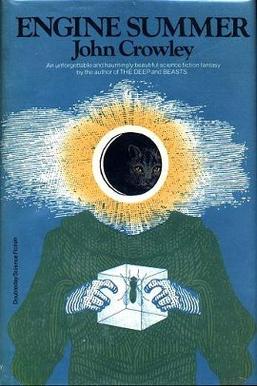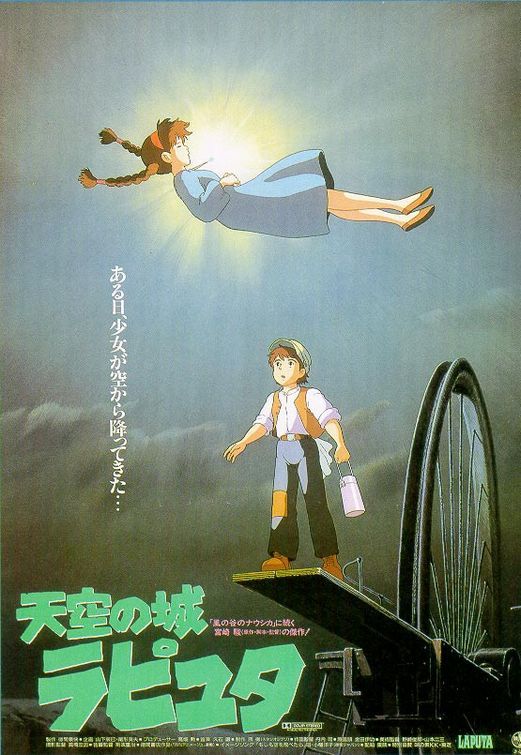Note: The following post discusses central aspects of the plots of both
the novel and the film under discussion, so for those who want a SPOILER warning, this is it. I
would also add that, when you get right down to it, no story with real merit can
ever truly be spoiled, whether you know the details of the plot or not.
The flying city of Laputa made its literary debut in 1726 as
an episode in Jonathan Swift’s Gulliver’s
Travels. In line with the vitriolic satire of the book, the inhabitants of
the flying island are idiots, conducting pointless experiments in a quest for
scientific discovery. They are literal and figurative airheads. Other artists
have taken an interest in Swift’s creation and put it to use in their own
works. I was recently struck by the motif of the flying island in
two distinct fantasy works: John Crowley’s 1979 novel Engine Summer and Hayao Miyazaki’s 1986 animated film Castle in the Sky (Tenku no Shiro Laputa). While
the flying island’s function in both stories is quite different, both Crowley
and Miyazaki provide a commentary on the nature of time, humanity’s place in the
natural world, and the ambiguous blessings of technology.
 |
| Illustration from original edition of "Gulliver's Travels" |
Crowley's novel stands as a refreshing example of a pastoral dystopian novel; there's not a zombie or cannibalistic motorcycle gang in sight. Any power to disturb comes from the implications of the narrative's questions than from any sort of grisly brutality. Cataclysmic disaster befell the earth in the distant past, with nature having taken over what was once contemporary civilization. The humans that do remain have reverted to the status of pre-modern communal societies. The hero, Rush That Speaks, hails from a collective named Little Belaire, whose inhabitants venerate "Saints", so named because they were "truthful speakers'. It is an oral culture; their only clues to the past the inherited stories of the Saints and the bits of debris that can be found(pill bottles, advertisements, etc.). Tales are told of "the Angels" who fled the earth when the great disaster came.
Rush That Speaks leaves Little Belaire in a quest to become a Saint himself(as well as to search for an enigmatic girl named Once a Day). He comes upon a series of perplexing encounters on his journey, but none more significant than a man who descends from the sky. He and Rush have a conversation, via a strange ear-device.
" 'I have come'--he pointed skyward-- 'from there. From a City there, some call it Laputa.'...He told me there were not cities in the sky, just this one called Laputa, which the angels had built when the last days were at hand...And so it rose into the sky, the whole mile of it, and, supported by its perfect simplicity, had floated ever since, while generations of angels had been born and lived and died there." (200) When Rush That Speaks asks why he has come, the Angel responds with a question: " 'How would you like to live forever, or nearly?' "(202)
The flying city is the residence of the humans who managed to escape from the ecological disaster on the earth. Unlike those left down below, they know what has happened, but still don't have the why. As those below seek to preserve artifacts to learn about the distant past, the Angels seek to understand what has happened through pure story. This is what Rush That Speaks is invited to become, a voice telling a story, forever and forever. TS Eliot writes in "The Dry Salvages" that "to apprehend/ the point of intersection of the timeless with time is an occupation for the saint", and this is ultimately what Rush That Speaks achieves, through the technology of the flying city. Engine Summer is out-of-print, but a copy can still be found through some online investigation(or, better yet, your local independent bookstore!).
 |
| The book's title is a reference to the oral tradition |
Hayao Miyazaki's Castle in the Sky, in some ways, presents a flip-side of Crowley's scenario. Instead of a post-apocalyptic distant future, the film is set in an alternate version of the 19th century where flight is possible. Laputa is the object of a quest for the young heroine and hero, as well as the military and a sinister government official with his own motives. The flying city is rumored to be a city of advanced technology, exemplified by its use of powerful levitation crystals.
But when Sheeta and Pazu arrive at Laputa, they find that it completely uninhabited, save for a single care-taking robot and the wild animals and birds living in the gardens. Humans have long vanished. Truth of the city's capabilities emerges when the evil Muska arrives, activating the weapons systems beneath the castle. He identifies the power of Laputa with the heavenly fire that destroyed Sodom and Gomorrah, with what the Ramayana dubs "Indra's arrow". It becomes clear that the Laputan civilization was a despotic one, reserving the finery above for its own elite and terrifying those below with its own brand of weapons of mass destruction. Muska is aware of this history and aims to restore the technological supremacy of the floating city. Sheeta, however, realizes the other half of the story. As she declares in her brave confrontation with the would-be-dictator, "No matter how great your technology, no matter how numerous your poor robots, humanity cannot survive apart from the earth."*
Humanity cannot survive apart from nature, but nature can survive apart from humanity, a revelation made by the island's central levitation crystal being encased by the root system of a gigantic central tree. As Helen McCarthy observes in her invaluable Hayao Miyazaki: Master of Japanese Animation, "it[Laputa's tree]serves as a metaphor for the reviving and life-giving power of nature, but its seemingly miraculous ability to save what is best and most beautiful about the flying city is a direct result not of magic but of its proper place in the eco-system."(98)
Engine Summer and Castle in the Sky provide a fascinating look at a how a single story element can be used to different but equal satisfying ends.
 |
| Original Japanese poster for "Castle in the Sky" |
 |
| Most recent edition of "Engine Summer" |
* The Disney English dub has the line "The world cannot live without love", thus drastically muting the film's themes. I strongly recommend watching the Japanese subtitled version of the film.

No comments:
Post a Comment